Affiliate disclosure: This post may contain affiliate links. Please see our Privacy Policy.
Herbal healing salves are simple and effective ways to enjoy the benefits of herbal medicine, and they couldn’t be easier to make at home. Salves are semi-solid at room temperature, making them easy to transport and store. When they come in contact with skin, the botanicals go to work, released by our own body heat for absorption through the skin.
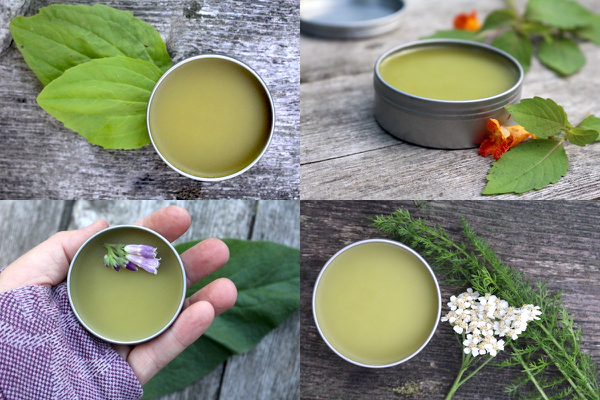
I’ll admit it, as a budding herbalist I was intimidated by making my own salves. Homemade tinctures and infused oils are easy enough, just place herbs in a medium and wait.
It took me over a decade of herbal practice before I made my first herbal salve. Start to finish, the whole process only lasted about 10 minutes and I had a whole counter full of homemade herbal medicines. Why had I waited so long to try this?!?!?!
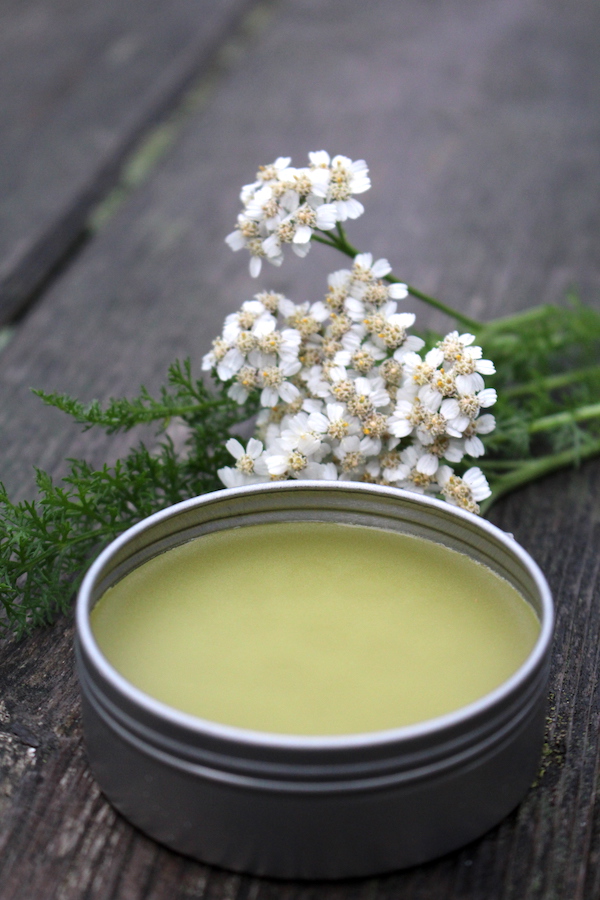
What is a Salve?
A healing salve is an oil-based medicine, generally used topically. A carrier oil is infused with herbs, resins or other medicinal compounds and then it’s thickened with a bit of wax (usually beeswax) for easier application.
Chapstick is one example, as many commercial chapsticks are simply herbal salves poured into an easy-to-apply tube. Some even come in tins, as they did long before inexpensive plastics became available.
These days, commercial versions of old-time salves often use petroleum-based oils to achieve a thick consistency. Neosporin and Vicks vapor rub are all good examples. Historically, those would have been healing salves made by blending healing botanicals with oil and beeswax.
Making your own healing salves allows you to control the ingredients, ideally sticking with organics and avoiding petroleum products whenever possible.
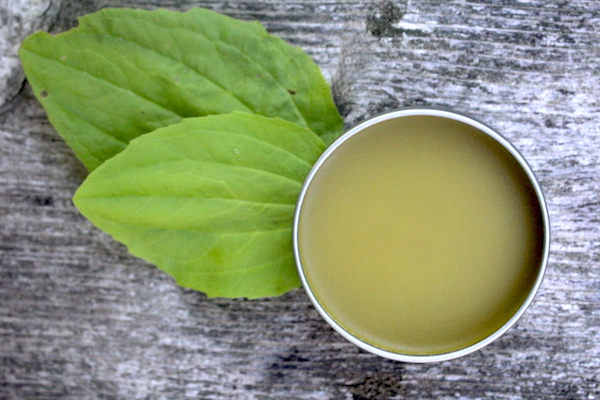
Ingredients for Healing Salves
Usually, healing salves are made with just a few ingredients. Often just three ingredients are enough to get the job done, those being herbs, oil, and beeswax.
There’s a base oil that helps to carry the medicines, while at the same time moisturizing and nourishing the skin. Most any oil will work, and generally, the choice is determined by personal preference. Olive oil makes a good all-purpose healing salve, and almond oil is especially nourishing to the skin (assuming no nut allergies).
Common choices include:
- Olive Oil
- Grapeseed Oil
- Almond Oil
- Jojoba Oil
- Coconut Oil
Using solid or semi-solid oils such as coconut oil or shea butter will result in a thicker salve, and it can be tricky (though not impossible) to infuse medicines into them. For beginners, I’d suggest starting with a neutral oil that’s liquid at room temperature (olive, grapeseed or almond).

Making a Herbal Infused Oil for Salve Making
The first step to making a healing salve is infusing the oil with herbs. Start by filling a mason jar about 2/3rds full with dried herbs. Allow the herbs to slowly infuse into the oil for 3 to 6 weeks before straining.
Working with fresh herbs is a bit trickier, and you have to speed the infusion process along with a bit of heat so the wet herbal material doesn’t spoil. For beginners, I’d suggest sticking with dried herbs, and drying any fresh herbs before starting.
That said, some herbs are only potent fresh, and you can only make Saint John’s wort oil and salve with fresh plant material. In that case, consult this guide on making herbal infused oils for the specifics of working with fresh herbs.
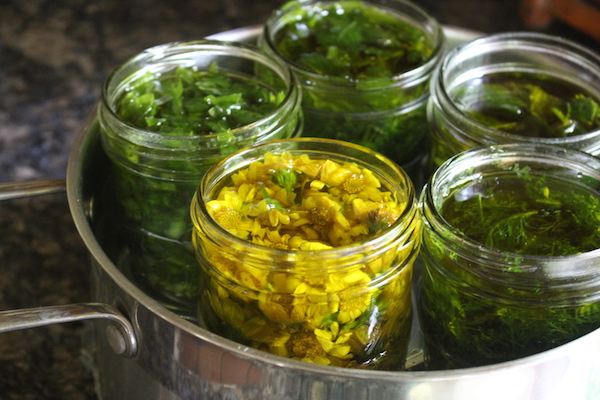
How to Make a Herbal Healing Salve
Once you have a herbal-infused oil, making a healing salve only takes a few minutes.
Place the oil into a heatproof bowl. Add about an inch of water to a small pot, and then place the bowl on top of the pot to make a simple double boiler. This allows you to gently heat the oil over the heat of the water below.
Ideally, you’re warming the oil just enough to melt the beeswax (or other wax of your choice). Beeswax melts at roughly 145 degrees F (or 63 degrees C), so it’ll only take a minute above simmering water to warm the oil.
Ratios for oil and wax vary considerably based on personal preference. You’ll find herbal salve recipes that use 1 part wax to 4 parts oil, and others that use as little as 1 part wax to 12 parts oil.
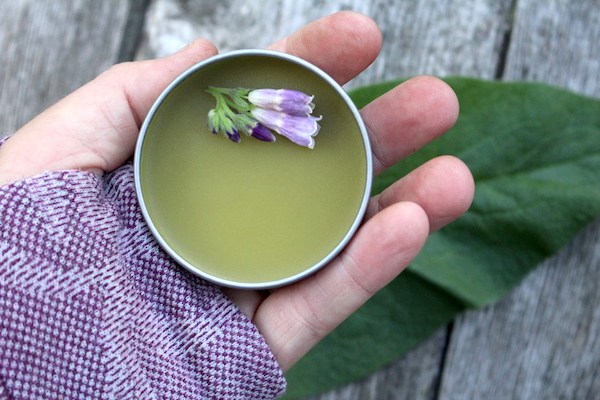
The amount of wax only affects the consistency of the finished healing salve, and for the most part, the medicinal benefits will be quite similar regardless of the amount of wax used.
Personally, I use 1 ounce of wax (by weight) for every cup (8 ounces) of herbal-infused oil. I measure the oil into a liquid measuring cup, and then I place beeswax on a small kitchen scale until it reaches 1 ounce by weight.
Beeswax can be tricky to measure by volume, especially if you’re using chunks off a solid block of beeswax. Lacking a kitchen scale, one ounce is roughly equal to a heaping tablespoon of beeswax pistils.
The exact measurement is not important, and really the amount of beeswax in a herbal salve is totally up to the user. If it’s not thick enough for your liking, just melt the salve back down and add more beeswax. Alternately, if it’s too thick, melt it back down and add more oil (ideally herbal infused oil).
Once the wax is melted, remove the bowl from the heat and pour it into containers. I like to use small salve tins because they’re easy to transport and they seal well. Small mason jars work well too.
Allow the salve to cool to room temperature and reach a semi-solid consistency before using it.
(Note: I’m not a doctor, nor do I play one on the internet. Please consult your doctor or a medical professional before starting a new course of medical treatment.)
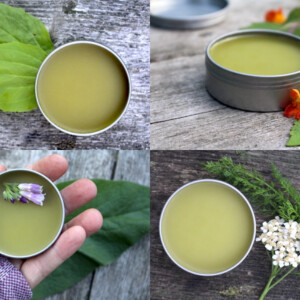
How to Make a Herbal Healing Salve
Equipment
- Double Boiler or saucepan & heatproof bowl
- Salve Tins or other small containers
Ingredients
Herbal Infused Oil
- 1 1/2 cups carrier oil olive, almond, grapeseed, etc
- 1/2 to 1 cup dried herbs
Healing Salve
- 1 cup 8 Ounces Herbal Infused Oil
- 1 ounce or 1 heaping tablespoon Beeswax Pistils
Instructions
Herb Infused Oil
- Add dried herbal material to a pint mason jar. Cover completely with about 1 1/4 to 1 1/2 cups of oil.
- Allow the oil to infuse at room temperature for 3 to 6 weeks before straining through a fine-mesh strainer. (Note: Some of the oil will absorb into the herbal material, so starting with slightly more than 1 cup of oil should yield about 1 cup for making a herbal salve.)
Herbal Healing Salve
- Measure about 1 cup of herb infused oil. Place it in a heat proof bowl (or double boiler). Add about 1 inch of water to a small saucepan and then place the bowl over the water. Turn the heat on low and gently heat the oil.
- Add in about 1 ounce of beeswax pistils (roughly 1 heaping tablespoon). Stir gently until melted.
- Remove the oil/wax mixture from the heat and pour it into containers.
- Allow the salve to cool to room temperature and reach a semi-solid state before using it.
Notes
Salve Recipes for Beginners
Ready to start making your own healing salves? Here are a few herbal salve recipes for common ailments to get you started:
- Comfrey Salve
- Pine Resin Salve
- Arnica Salve
- Gardener’s Healing Salve
- St. Johns Wort Salve
- Peppermint and Lavender Headache Salve
- Herbal Burn Salve
- Herbal Diaper Rash Salve



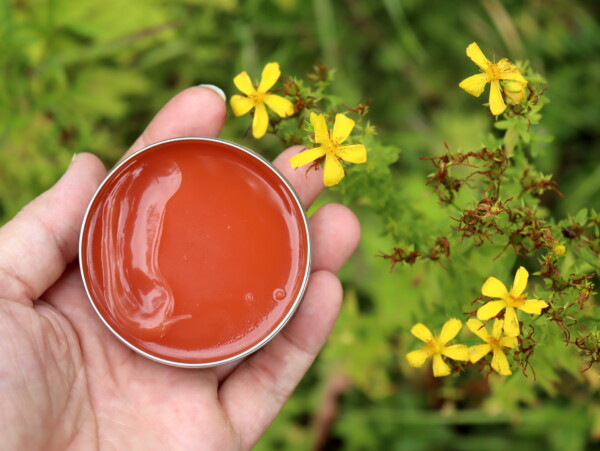
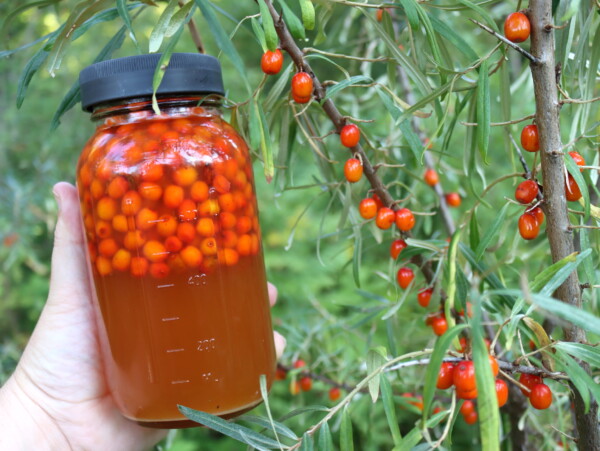










Hi! I’m currently prepping lavender in sweet almond oil to make a salve. I was wondering what you think about using tallow as my “wax.” I’ve had it in my fridge for a few months now just trying to find a use for it. If it makes a difference, it’s beef tallow.
You can definitely use tallow but you may want to use a little less than you would the beeswax because it won’t be as hard.
I wish you had a print option on your articles so I could open a new page with just the article no ads to print it
Can you consider putting that option for us- Thank you
You might want to consider checking out the Substack subscription for an ad free experience.
Hi,
I just read your article and want to make a healing salve for pain.
Can I use sesame oil, this is what I have on hand now? I’m also using frankincense oil in the salve instead of the herb.
Sesame oil will work just fine.
Hello! I’m a beginner at making herb salves and tinctures. I have a question about picking the herbs. Is there a best time for doing this when the herb is at its peak for effective healing chemicals? Does this vary according to herb? For instance, I have lots of plantain in my yard, and I planted comfrey this past summer. I understand the comfrey takes a while to reach its maximum effectiveness for the allantoin chemical in it. But can these herbs (including the comfrey once it’s ready) be picked in the fall/winter/early spring as well as in summer to make effective poultice/salve/tincture? I’d like to make some more plantain salve, but cold weather is coming in now here in northern Virginia. Should I wait til spring/summer? Also, when is the best time of day (if any) to pick? Thank you!
As a general rule, it’s a good idea to pick leaves before the plant flowers. Roots are usually picked in the fall. Flowers are picked when the plant is in flower. Typically the best time of the day to harvest is mid-morning after the dew has dried but before the sun is full. These are just general guidelines and for something like plantain, I think you can harvest at any time. My plantain usually has a second flush in the fall when we start getting a little more rainfall.
Do you know of one made for burns?
I was burned bad as a kid as and it was used on me and I have no scarring at all. Love find out ingredients.
It’s hard to say exactly what was used in the recipe that you had as a child but any skin healing herbs will most likely be beneficial. The oils that you use along with the beeswax in themselves can actually be very healing.
I have some dried herbs that I bought 2 or 3 years ago. I never got around to using them. Can I still use them to make a salve? Will there be any potency?
It’s a judgment call…depends on the herbs and how they’ve been stored. Do they still smell good, potent like they did when you got them? If so, I’d still use them, so long as they’ve been stored well.
Thank you! Your instructions were very helpful! I’m getting ready to make my first salve… I’m so nervous! Oh my goodness, I feel like I’m going to mess it up!
Thank you! Good luck!
It’s a revelation how easy it is to take healing into our own hands. Your website is such as boon. Thankyou so much for sharing x
Hi! I love your blog. What kind of herbs did you use in your salves and what different healing properties do they have?? Thanks!
Hi Ashley,
Can I use this same method using witch hazel and make a witch hazel salve? Do you have any other recommendations for witch hazel?
Thanks,
Steph
Yes, you can add witch hazel to a salve. I also have a witch hazel and yarrow soap that you may like: https://practicalselfreliance.com/yarrow-witch-hazel-soap/